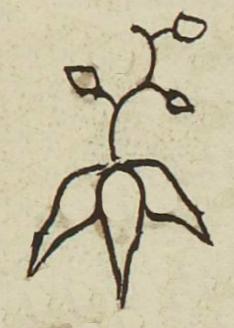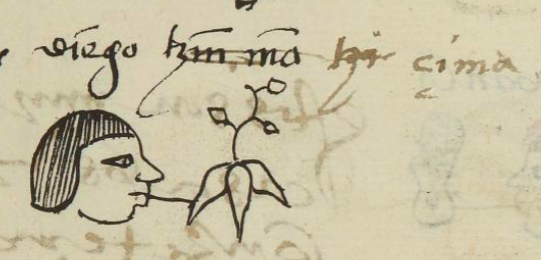Cima (MH531r)
This black-line drawing of the simplex glyph for the personal name Cima (“Wild Potato,” attested here as a man’s name) shows three bulbous roots with a leafy sprig above. The term cimatli refers to the root specifically. According to the Florentine Codex (1963, Book 11, 125 and 133), if not properly cooked, the root can cause vomiting and diarrhea. The plant above ground is the cuauheco.
There is a medicinal plant called cimapatli (or cimapahtli, with the glottal stop), which has possibly been abbreviated in the name.
Stephanie Wood
The cimatl is still widely eaten in Mexico according to Michel Conan, Sacred Gardens and Landscapes (2007, 85).
Other examples of this name include Cimatl (see below). While this Cima is a man's name, another Cimatl (in another source) was the mother of the interpreter to Cortés, doña Marina. (See: Antoinette Sedillo López, Latina Issues, 2020.)
Stephanie Wood
çima
Cima
Stephanie Wood
1560
Jeff Haskett-Wood
roots, raíces, medicinas, food, comida, edible herbs, medicinal herbs, hierbas comestibles, hierbas medicinales, plants, plantas, remedies, remedios, pahtli, patli, nombres de hombres

cima(tl), an edible root of an herb, https://nahuatl.wired-humanities.org/content/cimatl
cimapah(tli), medicinal plant of the bean family the root of which can be used to induce vomiting, https://nahuatl.wired-humanities.org/content/cimapahtli
Raíz o Tubérculo Comestible
Stephanie Wood
Matrícula de Huexotzinco, folio 531r, https://www.loc.gov/resource/gdcwdl.wdl_15282/?sp=141&st=image
This manuscript is hosted by the Library of Congress and the World Digital Library; used here with the Creative Commons, “Attribution-NonCommercial-ShareAlike 3.0 License” (CC-BY-NC-SAq 3.0).












